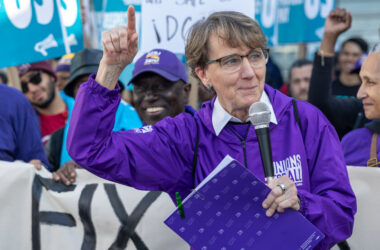The pandemic created an economic crisis unlike any recession on record. So perhaps it shouldn’t be surprising that the aftermath, too, has played out in a way that almost no economists expected.
When unemployment soared in the first weeks of the pandemic, many feared a repeat of the long, slow rebound from the Great Recession: years of joblessness that left many workers permanently scarred. Instead, the recovery in the labor market has been, by many measures, the strongest on record.
In early 2021, some economists foresaw a surge in inflation. Others were skeptical: Similar predictions in recent years — in some cases from the same forecasters — had failed to come true. This time, however, they were right.
And when the Federal Reserve began trying to tamp down inflation, there were warnings that the job market was sure to buckle, as it had threatened to do every time policymakers began raising interest rates too rapidly in the decade before the pandemic. Instead, the central bank has raised rates to their highest level in decades, and the job market is holding steady, or perhaps even gaining steam.
The final chapter on the recovery has not been written. A “soft landing” is not a done deal. But it is clear that the economy, particularly the job market, has proved far more resilient than most people thought probable.
Interviews with dozens of economists — some of whom got the recovery partly right, many of whom got it mostly wrong — provided insights into what they have learned from the past two years, and what they make of the job market right now. They didn’t agree on all the details, but three broad themes emerged.
1. This time really was different.
Economists have learned to be wary of concluding that “this time is different.” No matter how different the specifics, the basic laws of economic gravity tend to hold constant: Bubbles burst; debts come due; patterns of hiring and firing evolve in ways that are broadly, if imperfectly, predictable.
But the pandemic recession really was different. It wasn’t caused by some fundamental imbalance in the economy, like the dot-com bubble in the early 2000s or the subprime mortgage boom a few years later. It was caused by a pandemic that forced many industries to shut down virtually overnight.
The response was different, too. Never had the federal government provided so much aid to so many households and businesses. Despite mass unemployment, personal incomes rose in 2020.
The result was a recovery that was fast but chaotic. When vaccines enabled people to venture out again, they had money to spend, but businesses weren’t ready to let them spend it. They had shed millions of workers, some of whom had moved on to other cities or industries, or had started businesses of their own, or who weren’t available to work because schools remained closed or the health risks still seemed too great. Companies had to navigate supply chains that remained snarled long after daily life had returned mostly to normal, and they had to adjust their business models to schedules, spending patterns and habits that had shifted during the pandemic.
In retrospect, it seems obvious that normal economic rules might not apply in such an environment. Ordinarily, for example, when job openings fall, unemployment rises — with fewer opportunities available, it is harder to find work. But coming out of the pandemic shutdowns, even after the initial hiring rush slowed, there were still more vacancies than workers to fill them. And companies were eager to hold on to the employees they had worked so hard to hire, so layoffs remained low even when demand began to cool.
Some economists did recognize that the pandemic economy was likely to follow different rules. Christopher J. Waller, a Fed governor, argued in 2022 that job openings could fall without necessarily driving up unemployment, for example. But many other economists were slow to acknowledge the ways in which standard models didn’t apply to the pandemic economy.
“It’s the danger of forecasting what’s going to happen in extreme times from linear relationships estimated in normal times,” said Laurence M. Ball, a Johns Hopkins economist. “We should have known that.”
2. The job market is returning to normal — and normal is pretty good.
The job market doesn’t look so strange anymore. In fact, it looks largely as it did just before the pandemic began. Job openings are a bit higher than in 2019; job turnover is a bit lower; the unemployment rate is almost the same.
The good news is that 2019 was a historically strong labor market, marked by gains that cut across racial and socioeconomic lines. The 2024 version is, by some measures, even stronger. The gap in unemployment between Black and white Americans is near a record low. Job opportunities have improved for people with disabilities, criminal records and low levels of formal education. Wages are rising for all income groups and, now that inflation has cooled, are outpacing price increases.
“Normal” looks a bit different five years later, of course. The pandemic drove millions of people into early retirement, and many have not returned to work. The persistence of remote and hybrid work has hurt demand for some businesses, like dry cleaners, and shifted demand for others, like weekday lunch spots, from cities to the suburbs.
But while those patterns will continue to evolve, the period of frantic rehiring and reallocation is largely over. Workers are still changing jobs, but they are no longer walking out the door on their lunch break to take a better-paying opportunity down the street. Employers still complain that it is hard to hire, but they are no longer offering signing bonuses and double-digit pay increases to get people in the door.
As a result, many economic rules that went out the window earlier in the recovery may again be relevant. Without such an excess of unfilled jobs, for example, a further decline in openings may really augur an increase in unemployment. That doesn’t mean the old models will perform perfectly, but they may again bear watching.
“You can easily imagine that we had a period where, man, a lot of weird things happened, but now we’re coming back to a world we understand,” said Guy Berger, director of economic research at the Burning Glass Institute, a labor market research organization.
3. The good times don’t have to end (necessarily).
A few years after the end of the Great Recession, many economists began warning that the United States would soon run out of workers.
Employment had surpassed its pre-recession peak. The unemployment rate was approaching 5 percent, a level many economists associated with full employment. Millions of people had abandoned the labor force during the recession, and it was unclear how many wanted jobs, or could get one if they tried. The nonpartisan Congressional Budget Office estimated in early 2015 that job growth would soon slow to a trickle, just enough to keep up with population growth.
Those projections proved wildly pessimistic. U.S. employers added more than 11 million jobs from the end of 2014 to the end of 2019, millions more than what the budget office had expected. Companies hired job seekers they had long shunned, pushing the unemployment rate to a 50-year low, and raised wages to attract people off the sidelines. They also found ways to make workers more productive, allowing businesses to keep growing without adding as many employees.
It is possible that if the pandemic hadn’t happened, the job growth of the preceding years would eventually have petered out. But there is little evidence that was an imminent prospect in 2020, and there’s no reason it has to happen in 2024.
“A strong labor market sets off a virtuous cycle, where people have jobs, they buy stuff, companies do well, they hire more people,” said Julia Pollak, chief economist for the job site ZipRecruiter. “It takes something to slow that train and interrupt that cycle.”
Some sort of interruption is possible. The Fed, nervous about inflation, could wait too long to start cutting interest rates and cause a recession after all. And recent data may have overstated the job market’s strength — economists point to various signs that cracks could be forming beneath the surface.
But pessimists have been citing similar cracks for well over a year. So far, the foundation has held.



